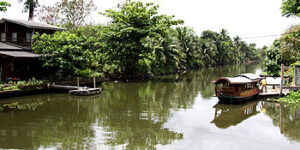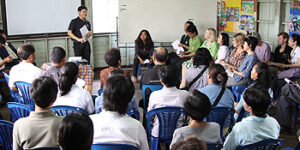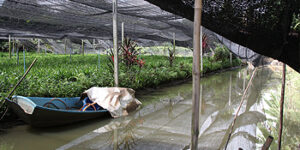
Meeting rooms may be where the formulas, figures and policies are debated, but negotiations must reach beyond these tables, beyond our national interest to that of the planet and humanity as a whole, notes Ms. Anna Lindstedt, Ambassador for Climate Change, Ministry of the Environment, Government of Sweden.

“In negotiation rooms, we’re so absorbed and forgot what’s going on in the real world,” Ms. Lindstedt told a gathering of community members. “That’s why it’s really important to come out to the real world and remember in the negotiation room what we’re negotiating for.”
Communities like Klong Jinda that illustrate what is already happening and the struggle to plan for an uncertain future made only harder without any solid global plan to cut CO2 emissions and reduce the uncertainty that lies ahead.
“We grow some of the highest quality fruits in Thailand,” asserts Pichai Thongsima, owner of a rose apple orchard, “Klong Jinda, literally the canal of gems, used to be the source of abundance. But the warm climate has affected pollination. And it’s not only year on year, there’s increasing climate variability within seasons and even days. We get a lot less fruits over the years and have to constantly change the type of fruits and the growing techniques to adapt to the climate.”

Ms. Lindstedt notes that her broader perspective is in no small part influenced by previous time in the region, serving as Ambassador to Vietnam from 2003 to 2006, and more recently the same post in Mexico into 2011. Spending so much time in these countries helps, “climate change adaptation differs from region to region and context specific,” she stresses.

Echoing the experiences of the Klong Jinda community, and joining in the reception of the climate change ambassador, were farmers from the upper basin community of Saphan Hin in Chai Nat Province.
“A growing number of farmers in our area have switched from rice to sugar cane because the latter crop needs less water,” adds community leader Supat Chansri. “This is to address the fact that warmer climate and drought have become our new reality.”
Ms. Lindstet’s visit to Klong Jinda lead off her keynote address at the Asia Pacific Climate Change Adaptation Forum co-organized by SEI Asia Centre on 12-13 March, 2012. Nearly 900 representatives from governments, researchers, media professionals, development banks and agencies registered to attend the forum.
“Poor countries and poor people everywhere will be hardest hit,” she says, adding that communities need international supports and technology transfer in developing adaptive capacity to increase their abilities to manage risk and build a more resilient society.

SEI Asia Centre has been working with the Saphan Hin community in a pilot project to document community level climate change adaptation needs and responses in partnership with the Regional Climate Change Adaptation Knowledge Platform funded by Sida.
Photos: Noraset Kunjara
Design and development by Soapbox.